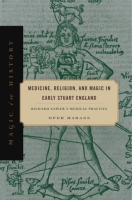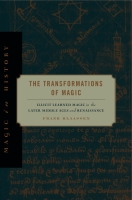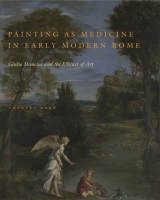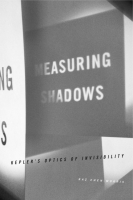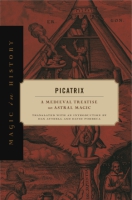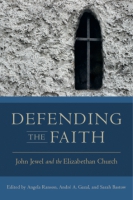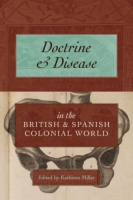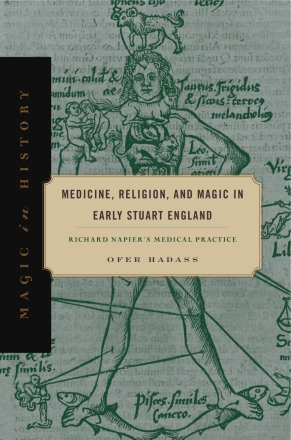
Medicine, Religion, and Magic in Early Stuart England
Richard Napier's Medical Practice
Ofer Hadass
Medicine, Religion, and Magic in Early Stuart England
Richard Napier's Medical Practice
Ofer Hadass
“A compelling study. . . . This volume informs the eventual separation of religion and magic.”
- Description
- Reviews
- Bio
- Table of Contents
- Sample Chapters
- Subjects
Originally trained in theology and ordained as an Anglican priest, Napier later studied astrological medicine and combined astrology, religious thought, and image and ritual magic in his medical work. Ofer Hadass draws on a remarkable archive of Napier’s medical cases and religious writings—including the interviews he claimed to have held with angels—to show how Napier’s seemingly inconsistent approaches were rooted in an inclusive and coherent worldview, combining equal respect for ancient authority and for experientially derived knowledge. Napier’s endeavors exemplify the fruitful relationship between religion and science that offered a well-founded alternative to the rising mechanistic explanation of nature at the time.
Carefully researched and compellingly told, Medicine, Religion, and Magic in Early Stuart England is an insightful exploration of one of the most fascinating figures at the intersection of medicine, magic, and theology in early modern England and of the healing methods employed by physicians of the era.
“A compelling study. . . . This volume informs the eventual separation of religion and magic.”
“A thoughtful and comprehensive intellectual biography of Richard Napier. The book will be of great use to scholars and students for its clear introductions to complex topics, such as early modern astrology and the occult. The book also illuminates the fascinating mental world of Napier, which offers rich insights into beliefs and practices of the age.”
“A provocative intellectual biography.”
“Hadass has performed an incredibly helpful service in bringing Napier and his records to light.”
“Hadass successfully explores the interaction of astrological, magical, and angelic divination with theological understandings in the work of Richard Napier, providing for the first time a rounded view of this Anglican priest-physician and an invaluable guide to those wishing to use Napier’s uniquely rich collection of manuscripts.”
“Illuminating and effective, making a learned and worthwhile contribution to our understanding of early modern magic and its religious milieu.”
“Part biography, part analysis of Napier’s work, this volume is valuable for deepening our understanding of the ways authority and knowledge were conceived in the early modern period, and how this fed into both the theological and medical spheres.”
Ofer Hadass is Director of Technology at the Division of Health Insurances of Clalit Health Services and Research Fellow at the Center for Health, Humanism, and Society, Ben Gurion University of the Negev.
Contents
List of Illustrations
List of Symbols
Acknowledgments
Conventions
Introduction
1. Astrological Medicine
2. Astral Magic
3. Converse with Angels
4. Religion and Knowledge
Conclusion
Notes
Bibliography
Index
From the Introduction
When Elizabeth Jennings, a girl of thirteen from Isleworth, Middlesex, became “strangely sick” in the winter of 1622 after being frightened by an old woman who allegedly asked her for a pin, bewitchment was immediately suspected. Seventeenth-century witchcraft accusations connected to personal illness were extremely frequent, especially when the symptoms were strange or unexpected, and this poor girl appeared a typical victim. As Elizabeth grew increasingly ill, losing the ability to walk and repeatedly refusing to eat, her parents called for “Doctor Fox,” who took her to London. Often weeping or sighing, she complained of aches in her knees, arms, head, and heart that suddenly moved from one part of her body to another. She became speechless and was often seized with extreme convulsions that caused loss of motion in her right arm. A consilium of learned physicians prescribed her a vomit, a letting of blood, and a bath of oil; yet such treatment wrought no amendment. Suspicions of witchery were confirmed when, during one of her trances, Elizabeth announced that she had been forespoken by four women, chiefly one identified as Margaret “Countess” Russell: “Jane Flower, Katharin Stubbs, Countesse, Nan wood, These have bewiched all my mothers children. East, west, north and south all these lye. All these are damnable witches. . . . Put Countesse in prison this child wilbee well. If she had bin long agoe all th’other had bin aliue. Them she bewiched by a catsticke. Till then I shall lye in great paine. Till then by fitts I shalbe in great extremitie.” Following this accusation, “Countess” was arrested and imprisoned, and a formal court inquest was initiated. Yet despite some short-term improvement, Elizabeth’s bouts with hysteria continued well into the summer, and Lady Jennings, desperate to cure her daughter’s condition, called on the help of Richard Napier, a medical practitioner from Great Linford in Buckinghamshire.
A self-made astrologer-physician, who was by then known across the Southeast Midlands as a successful healer and a master of occult arts, Napier was treating around thirty patients a week. Although he was accustomed to cases of suspected witchery, as well as to clients from the ranks of the gentry, it was nonetheless unusual for him to see a patient after unsuccessful treatment by members of the College of Physicians of London. “Hearing that I have helpen many in that kind,” he remarked rather complacently in his medical diary, Lady Jennings “hath written to me to come to London.” Taking appropriate extra care, Napier documented at relative length noteworthy events from Elizabeth’s recent medical history and drew an astrological chart for each of these significant occasions, as well as for the child’s nativity. Beside each astrological figure he noted important planetary aspects and made some astrological calculations that showed that Elizabeth was suffering from epilepttia matricis or morbus matricis. Such astrological judgments stood at the core of almost every medical encounter in Napier’s clinic, although in more typical cases a single chart was cast for the moment of the question. As in other astrological-medical practices, Napier used astrology as a tool to reveal the inherent cause of disease, determine an appropriate course of cure, and assign prognosis. It was an instrument of his practice, embedded within the more traditional view of disease as an “imbalance” or “corruption” of bodily humors. Napier’s exceptional reputation, however, was mainly due to his alleged ability to consult with angels, especially the archangel Raphael. Elizabeth’s case demanded such extraordinary means, and Napier confronted Raphael with a query that is now bound toward the end of the same medical diary: “Wheather young ms Elis[abeth] Jennys of 13 y[ears] be bewitched or only be troubled with the epilepsye of the mother & [whether] I shall cure her & howe
& wheather on[e] called goody countis be a wytch and hath done it.” He quoted Raphael’s harsh reply—“[she] will dye halfe a yere henc”—alongside the question and copied it word for word into the original case record. Three days later, probably following another spiritual conference, he noted a similar judgment, this time confirming that the girl was indeed bewitched. Underneath this more elaborate response, however, appears an apparently retrospective remark, announcing that the allegations “proved all false.” The source of this surprising contradictory judgment is not stated. As in many other cases, angelic guidance provided Napier with a sense of confidence about the facts of the medical situation, gained through the trustworthy testimony of a higher member of the cosmic order. In this particular episode, however, it seems that angelic authority failed to assist him in clearing the allegations of witchery.
Elizabeth lived beyond the six months granted her by the angels, and her mother continued to consult Napier, making further use of his versatile repertoire of treatments to promote her children’s health. In the autumn of 1631 Napier prescribed Elizabeth an astrological talisman (“sigil”) engraved with the characters of Jupiter. The same magical cure was prepared for her brother Thomas, who “vppon mistaking put his [sigil] on a great while before the houre.” Astrological talismans were a form of natural magic: part of Napier’s arsenal of magical and spiritual cures that included the use of sigils, pomanders, charms, prayers, and exorcisms. Their employment was based upon the conviction that astral influence operated through the same principles of sympathy and antipathy that were utilized in traditional learned medicine, and that certain astrological symbols, when cast at select times on the appropriate metal or stone, could be used to draw down celestial forces to effectively combat disease.
An eclectic approach such as Napier exhibited in the Jennings case was not an early modern novelty. Ancient and medieval medical practitioners had also offered a combination of natural treatments together with magico-religious ones. However, the profusion of medical theories that characterized the sixteenth and seventeenth centuries brought such eclectic practices to a peak. The expanding use of astrology and alchemy in medicine, the increasing utilization of chemical remedies, and the revitalization of certain magical and “hermetic” traditions significantly widened the range of knowledge systems and healing methods available to the early modern physician. Napier’s position as the Anglican rector of his parish, purportedly obliged to assume a more orthodox outlook and abstain from unsanctioned occultism, only emphasizes the puzzle inherent in his recourse to such an amalgam of partly suspect techniques.
Inspired by the practical and intellectual history of an era characterized by a conceptual change of attitudes, I have set out to examine how Napier’s seemingly eclectic reconciliation of such diverse approaches was possible. Given the increasingly fragmentary narrative of early modern English history, a broad investigation into Napier’s life and work seems to challenge current approaches to this question. Writing from the perspective of the history of medicine, I employ Napier’s engagement in certain intellectual and practical traditions in order to suggest that his versatile endeavor was in fact guided by a perfectly coherent view of nature and God. Nonetheless, his creative use of assorted practical means contributed to his immense popularity, attracting thousands of patients to the pastoral meadows of North Buckinghamshire.
Only a few stone houses of the seventeenth-century village remain, contained on either side of High Street in Dovecote Croft, Great Linford. Set back from this quiet lane stands the most significant remnant of the village’s glory days: an impressive stone building known as the “Old Rectory.” Much altered since it housed Napier’s residence and medical practice four hundred years ago, it has an old tile roof, a central oak door, and four ornamental brick chimney stacks. Going round the big house, which is now vacant, one can only imagine the noisy bustle of the seventeenth-century medical practice, crowded with worried patients and housing overnight guests and long-term apprentices. Heading north from the Rectory, through the old manor gates, a yellowish track crosses a large meadow toward the renovated Manor House, which once belonged to the Napiers. A footpath and a two-minute walk uphill lead to the parish church of St. Andrew’s (fig. 1). Surrounded by fragrant flowers and ancient graves, the main building of the church almost hidden among tall maple trees, its thirteenth-century tower seems to rule over the entire area. In the recently decorated interior, Napier is named last in an improvised list of medieval and early modern rectors hung on the wall near the altar. This short walk, from his residence and medical practice in the Old Rectory to St. Andrew’s Church, where he served as the local priest, provides a good parallel to Napier’s life story, linking his separate, yet inextricably related vocations of religion and medicine.
Born in Exeter in 1559 to Ann (Agnes) and Alexander Napier (alias Sandy), the younger son of a noble Scottish family from Merchiston that came to England in the reign of Henry VIII, Richard Napier had four sisters and was the youngest of three brothers. Having no children of his own, he kept in close touch with most of his siblings and nephews, particularly with the family of his elder brother Robert, whose second son, Sir Richard Napier, was to become Napier’s protégé and inherited his entire property and medical practice. Not much is known about our Napier before he arrived at Great Linford, but in a rare account of his life’s accidents he recalls how, when he was a boy, his mother, “casting a candlestick in her anger to one of my sisters, . . . steeping [sic] the candle stick lighted vppon my head being a sleepe in my bed, & I blead sevrely vppon it.” Napier entered the University of Oxford at the age of eighteen to study theology, receiving his BA in 1584 and an MA a couple of years later. He was elected a fellow of Exeter College in 1580, a position he held until he moved to Great Linford. “When I was a scholer in Oxford,” he proclaims in the same autobiographical note, “[I was] mutch given to study, no mynd to marriage, very earnest in disput[e].”
Admitted to the parsonage of Great Linford in May 1589 with the help of some family connections, Napier substituted the challenging academic setting of the university for the seemingly calmer position of a country vicar. Yet “extreme fearfull by nature to declayre or preache,” as he himself admitted, he soon hired a curate to handle some of his ministerial duties for him. Napier first became engaged in the practice of medicine in 1596, after seeking the aid of the famed (yet notorious) astrologer-physician Simon Forman in some medical and personal matters. Extending what might have been an existing interest into an actual occupation, he spent several periods at Forman’s house in Lambeth, London, learning the secrets of astrological medicine and geomancy. Back in Great Linford, Napier started to resolve medical questions for his relatives, acquaintances, and neighbors, rapidly expanding the scope of his practice into a full-fledged vocation. Treating both commoners and gentry from an area much larger than that of a modern general practitioner, he established a prosperous career in medicine that lasted until his death in 1634. Thanks to his influential patron, Lord Thomas Wentworth, and as a physician practicing in rural Buckinghamshire, Napier managed to sidestep the medical politics of London and avoid confrontation with its institutional authorities. Consulted by fellow practitioners and hosting aspiring apprentices who came to Great Linford to learn the secrets of medicine and magic, he became known over time as a most skillful physician and adept in occult arts.
Napier systematically recorded the consultations he held with his patients, leaving behind one of the most outstanding recorded examples of early modern medicine and certainly the richest one known. This huge collection of medical records—almost sixty volumes of documented medical encounters—was left upon Napier’s death to his nephew, Sir Richard, and, after the latter’s demise in January 1676, was handed by his son Thomas to Elias Ashmole, a renowned antiquary and charter member of the Royal Society, who bound, numbered, and organized the papers. Together with the rest of Ashmole’s enormous collection of occult material, Napier’s medical diaries were housed in the Ashmolean Museum, Oxford, until 1860, when they were moved to their current dwelling in the Bodleian Library. The generous gift was not always appreciated, as is evident from a letter written in 1693 by the second keeper of the Ashmolean Museum to one of its benefactors: “You take care to send us nothing but what is valuable & pertinent. But I could heartily wish Mr Ashmole had also done the same in his Legacy of Books; & instead of many ms volumes of Mr Napiers Astrological Practice in Physic, & above five hundred other Astrological books, I wish he had given us 50 of his best books relating to coyns and other antiquities, & to Natural Philosophy. Tho’ his donation be in its kind, also very usefull & considerable.” A minority of the medical documents (mostly explicitly magical material) was probably kept by Napier’s grand-nephew Thomas; these documents later found their way to the Sloane Collection in the British Library in London.
(Excerpt ends here)
Mailing List
Subscribe to our mailing list and be notified about new titles, journals and catalogs.
